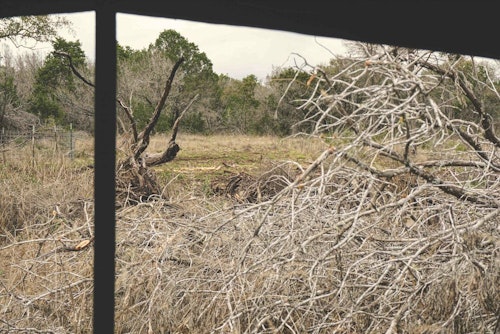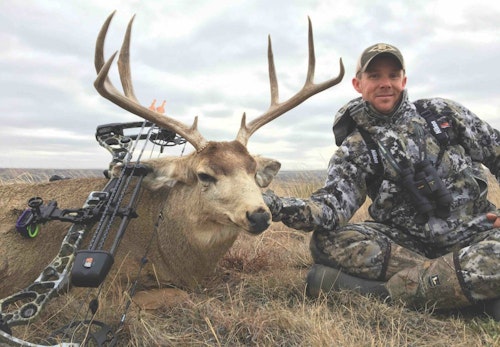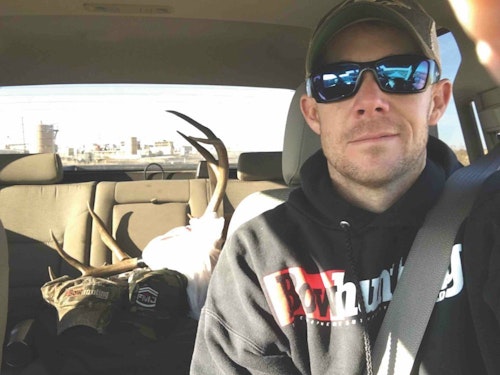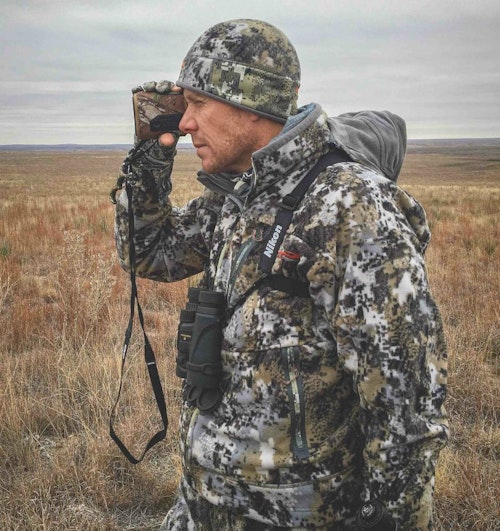I love Texas. That’s no secret. As a bowhunter, how can you not? During Lone Star State sits I’ve been treated to parades of whitetails, axis deer, hogs, turkeys and javelina. Twice I was fortunate enough to empty my five-arrow quiver. The result of these arrow-flinging escapades was six dead hogs, two whitetail does and a pair of whitetail bucks.
Naturally, it didn’t take me long to yell, “Yes!” into the phone when my buddy and Media Direct Creative President Mark Sidelinger extended a December bowhunt invite to north Texas. I’d never hunted that part of the state, and when Mark told me trophy mule deer roamed the ranch, and that spot and stalk would be part of the hunt, I got pretty excited.
My Chevy told me that the air temp was 10 degrees when I put my truck in park in front of the main cabin. Inside, Mark, his wife, Kim, Easton’s Gary Cornum and a few other hunters sat at a table around a steaming pot of green chili.
Not one to be bashful, especially when it comes to food, I joined my friends and received the lowdown from guide Tyler Hofferth of Sneed Ranch Outfitters. Tyler, I could tell from the get-go, was a straight shooter. He told us right off that we shouldn’t expect to see the numbers of whitetail one would see in the hill or brush country. He told us these open-country whitetails spooked easily. He told us it was going to be tough.
“These whitetails are super skittish, and because we don’t have the thick trees and brush, there simply aren’t the numbers,” he said. “What we have going for us is the fact that we have thousands and thousands of acres of land and are able to focus hunters in areas with higher concentrations. If we strike out on whitetail, we can try our hand spotting and stalking mule deer. The rut is still kicking — only a little, but still kicking — and we can slither around after a mature buck.”

Later that evening, I told Tyler that I’d been blessed to sit lots of Texas ground blinds, treestands and tripods for whitetail over the years, and that I would really, if it was OK with him, prefer to spot-and-stalk muleys in the Texas sage. A smile spread across Tyler’s face. Yes, this man was my people.
What I found out the following morning is that Tyler Hofferth is a hunter in the truest sense of the word, a guy who loves to walk and cover country. And cover the country we did. For two full days, Tyler and I walked and walked and then walked some more. I was fine with it. I love the grind. We passed up four different muley bucks, young up-and-comers we could have easily dropped the string on but didn’t. Tyler, when it comes to mule deer at least, follows a strict management plan, harvesting only mature bucks or old worn-down battlers boasting a 3x3 frame.
“I love these mule deer,” Tyler told me on the second morning of the hunt as we bounced along a no-name ranch road to parts unknown. “They are such a special critter, and we can grow some big ones on this place. The ranch is so big the bucks stay on it and have a chance to really grow. My job is to make sure they get the chance to grow to maturity.”
Tyler doesn’t take this grow-to-maturity job lightly. He looked over every buck we found for at least 15 minutes — even the smaller ones.
Conditions on the third morning of the hunt were ideal: cloudy, hardly any wind and temps in the high 20s. Tyler’s plan for the morning of day three was to do less walking and more glassing. As dawn broke over the frosted landscape, I noticed we were, by north Texas standards anyway, on a very high point. We could see for miles in every direction.

Optics Field Test
During that morning, I had plenty of opportunities to put my Nikon Monarch 60ED-A (Angled) Field Scope to the test. It passed with flying colors. Even in the morning’s haze, this scope gathered light and made colors pop. In addition, I appreciated the sizeable focus wheel located on the scope’s body and the sharpness provided by the newly designed MEP eyepiece.
“I’ve glassed lots of deer from here,” Tyler said. “We can see lots and lots of country, so we really need to be patient and pick it apart time and time again.”
I was ready. Glassing for hours on end was nothing new to me. I hopped out of the truck, set up my Nikon spotter, plopped my butt on the ground and gave a distant pasture a quick scan with my 12s. I wasn’t ready for what my binos instantly detected. If you’ve hunted long enough and spent enough time behind the glass, you know exactly what I’m referring to. Rare are those times where you lift your glass to examine a sea of vast openness and your lenses are filled with game.
He was a shooter. I spent several minutes looking at him through the spotter. I didn’t say anything at first, but after inspecting the wide, heavy 3x3 for more than 15 minutes, I motioned for Tyler to come over and have a look. After a quick glance through the scope, Tyler said, “I know right where he is. He has lots of does, but the cover in that pasture is good. Let’s get a closer look.”
Using the ranch truck rather than trying to traverse the open terrain between the buck and our glassing position was the right call. The buck and his does hardly ever looked in our direction as we skirted their position. When Tyler stopped the truck, my Sig KILO rangefinder told me the buck was 596 yards away. He was feeding casually behind his does, working his way toward an adjacent pasture.
A good rangefinder is a must, especially when you’re spotting and stalking in open country. I’ve yet to test one that provides as quick of a yardage readout as Sig’s KILO2200MR. I also loved the fact that the KILO’s Lumatic Display automatically calibrates yardage display brightness to the ever-changing ambient light conditions.
The cover was sparse, and as I slipped into my knee pads and leather crawling gloves, Tyler whispered, “I think we can use the truck to get closer. I think if you go from here you will blow him out. Lots of eyes. Plus, I think I know exactly where he will cross that two-track separating the pastures.”
I was reluctant at first. But the more I thought about it, the more sense it made. These deer were used to seeing ranch and oil trucks all day, every day.
Once again, we loaded up and slowly worked our way toward the moving buck. When we reached the two-track, the buck and his ladies were still coming and were now only 220 yards out. Tyler stopped. They kept coming, picking at the sparse grass, barely exerting enough effort to raise their heads and gaze in our direction. I simply stepped out of the truck and Tyler drove away.
The sting of a thousand sandburs hit me the second I hit the ground. My knees and hands screamed out in pain. I couldn’t glass him. I couldn’t get a range. Instead, I pulled out my pocket knife and dug away at the barbs stabbing into my skin. Finally, though I didn’t get them all, I was able to peek up and range the approaching herd. They were stopped — not at all alarmed — and feeding. My rangefinder told me the distance was 124 yards. I crawled, my knees grabbing more and more spines, 30 yards to a large patch of sage. Slowly, like a wary prairie dog accustomed to dodging .223 rounds, I inched my eyes above the sage. The group was walking, working left, 80 yards out and skirting my position. They hadn’t seen me. Not one of the does was looking in my direction, and the buck was moving lazily behind the herd. The group had, as traveling animals tend to do, simply meandered in a less-than-ideal direction.
When their white butts were facing me, I made a quick but very painful move (I hate sandburs). Luckily, they didn’t detect my 20-yard crawl, and rather than continuing their march away from my position, the herd stopped and resumed feeding. The buck was 60 yards away, quartering hard away from my position, totally relaxed with his head down. I pressed my Mathews HALON 32 into action, placed my pin and pounced on my release.
Not what you were expecting? No, I didn’t squeeze through my shot. The second my pin hit its spot, I punched my release. The hit was bad. I was sick. To this point in the season, I’d made a number of well-executed shots, but this time I crumbled. Everything I knew about shot execution went out the window.
The Truth
I didn’t make a perfect shot. The release of my arrow sucked, and I’d rather you know that fact than think every arrow a veteran bowhunter releases is a good one. I got excited and panicked. Every bowhunter is going to miss. Every bowhunter is going to make a marginal shot. Our job is to learn from these experiences, to evaluate what went wrong, to work harder to make sure our next opportunity results in a pair of deflated lungs.
I was sure I’d hit the buck, but where I had no idea. At the impact of the arrow, I saw the buck kick off to the side with his right-hind leg. Then I saw the yellow wrap of my arrow. That was it. The herd ran 200 yards and stopped. The buck didn’t miss a stride. When they stopped, I threw up my binos and detected a faint hint of blood in the flank area. Not good.
We watched the herd for over an hour. The buck never bedded down. Instead, he courted his does and munched at the short grass. With each passing second, the uneasiness in my stomach intensified.
We decided it was best to make a second stalk, but as we were preparing to do so, the buck bedded. Minutes later his head fell below the sage. The sickness I was feeling turned to excitement. That excitement, sadly, was short lived. Within seconds his head popped above the sage once again, his mouth grinding away at some just-nibbled grass. Another hour passed, and the buck continued his head-above, head-below the sage routine. Only now, it was becoming obvious that he wasn’t lowering his head to eat. He was getting sick.
The next morning, we found the buck right where we’d left him. The shot, though bad, had entered the body cavity and punched the buck’s stomach. Though it wasn’t the hit I’d hoped for, I was thrilled we were able to harvest this magnificent mule deer buck, a buck whose teeth were aged by biologists and found to be 8.5 years old. Did I mention I love Texas?









